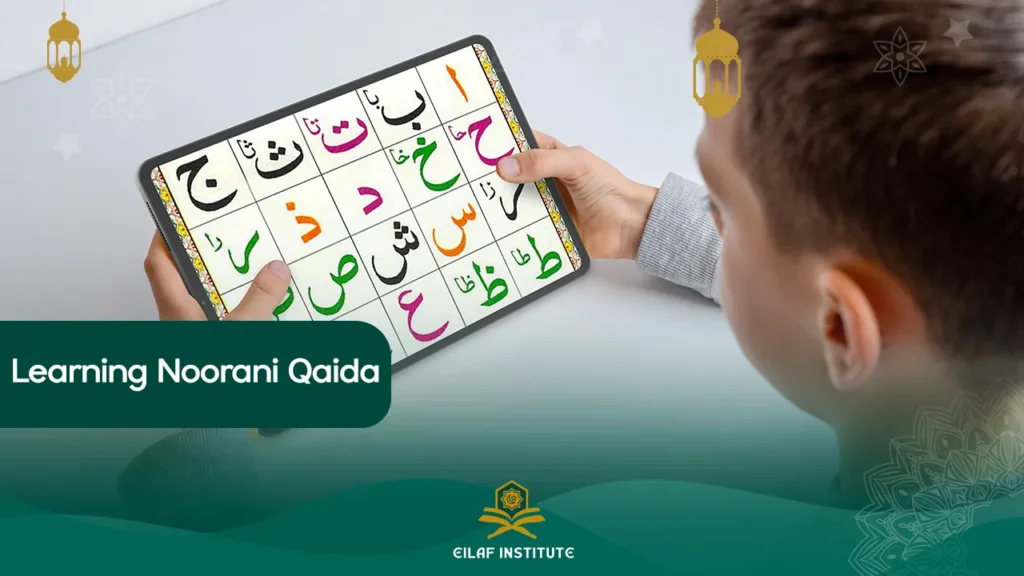Learning Noorani Qaida is the bedrock upon which accurate Quranic recitation and comprehension are built, preparing students of all ages for a lifetime of spiritual engagement.
In this guide, we’ll explore the importance and benefits of Noorani Qaida, and highlight where you can learn it online through trusted platforms and qualified teachers.
What Is Noorani Qaida and Why Is It Important for Beginners?
Noorani Qaida is a beginner-friendly guide that teaches how to read Arabic letters and pronounce them correctly, making it an essential first step before reading the Quran.
It’s a structured curriculum that breaks down Arabic phonetics and Tajweed into simple, progressive lessons.
Why it’s important:
- Letter Recognition: Identifying letters in both isolated and joined forms.
- Vowel Sounds (Harakat): Learning short vowels, Fatha, Kasra, and Damma.
- Madd (Long Vowels): Practicing proper vowel elongation.
- Tanween: Understanding the “n” sounds at word endings.
- Sukoon & Shaddah: Mastering silent and doubled letters.
- Joining Letters: Learning to read complete words and sentences.
By mastering Noorani Qaida, beginners build a solid foundation in pronunciation and Tajweed, preventing common recitation mistakes and ensuring a confident transition to reading the Quran correctly.
Top Benefits of Learning Noorani Qaida for Children and Adults
The structured approach of Noorani Qaida offers a multitude of benefits, making it an ideal starting point for anyone, regardless of age:
Correct Pronunciation:
It meticulously teaches the precise Arabic alphabet pronunciation (Makharij ul Huruf), ensuring each letter is articulated from its correct origin point in the mouth or throat. This is vital for preserving the Quran’s linguistic integrity.
Foundation for Tajweed:
The Qaida introduces fundamental tajweed basics like Madd, Sukoon, and Shaddah. This early exposure builds a strong foundation, making it easier to grasp advanced Tajweed rules later on.
Enhanced Confidence:
Successfully navigating the Noorani Qaida instills a significant sense of accomplishment and confidence, empowering students to confidently approach the Quran.
Accessibility for All Ages:
While often associated with Islamic learning for kids, its clear and incremental methodology makes it equally effective for adults who are new to Arabic or wish to refine their recitation.
Spiritual Connection:
Accurate recitation deepens one’s connection with the Quran, allowing for a more profound and meaningful engagement with Allah’s words.
Reduces Errors:
By mastering the basics, students significantly reduce the likelihood of making common recitation errors, ensuring they recite the Quran as it was revealed.
Join the Noorani Qaida course and start learning to read the Quran today.
How Learning Noorani Qaida Builds a Strong Tajweed Foundation
How Learning Noorani Qaida Builds a Strong Tajweed Foundation
Tajweed, the art of Quranic recitation, relies on precise pronunciation, rhythm, and flow.
Noorani Qaida lays this foundation by introducing core Tajweed rules from the start in a simple, structured way.
It trains both the ear and tongue to recognize and produce correct Arabic sounds. Key elements include:
- Makharij: Exact articulation points of each letter.
- Sifat: Letter characteristics (e.g., heavy vs. light sounds).
- Basic Madd Rules: Understanding vowel elongation.
- Noon Sakinah & Tanween: Rules like Izhar, Ikhfa, Idgham, and Iqlab.
Through repetition and gradual progression, students build muscle memory and intuitive pronunciation.
This makes the shift to proper Quran recitation with full Tajweed natural and smooth.
Read also: How Do I learn To Read The Quran Fluently?
Step-by-Step Guide to Learning Noorani Qaida Effectively
Learning Noorani Qaida requires structure, patience, and daily effort. Here’s a simplified guide to help you progress effectively:
Start with a Qualified Teacher
A skilled Qari or Qariah ensures correct pronunciation and provides real-time feedback, something self-study or online tools alone can’t offer.
Learn Arabic Letters (Makhraj)
Begin with the 29 Arabic letters, focusing on correct articulation and shape. Repeat until you’re confident.
Understand Harakat (Short Vowels)
Learn how Fatha (ـَ), Kasra (ـِ), and Damma (ـُ) affect letter sounds, and practice reading them in combination with letters.
Master Madd Letters (Long Vowels)
Study Alif, Waw, and Ya when used to extend vowel sounds. These are vital for fluent recitation.
Learn Tanween
Practice double vowel sounds: “an”, “in”, and “un” to improve word endings.
Grasp Sukoon & Shaddah
Understand the silent Sukoon and the doubling effect of Shaddah to read words accurately.
Practice Joining Letters
Start combining letters into words, this is where real reading skills begin to develop.
Stick to a Daily Routine
Just 15–20 minutes of daily, focused practice is more effective than irregular, long sessions.
Listen and Repeat
Imitate audio recitations from skilled readers to improve your tajweed and rhythm.
Review Regularly
Revisit earlier lessons to reinforce learning and correct any lingering mistakes.
Know more about Tajweed Rules
Common Mistakes to Avoid When Learning Noorani Qaida
While the journey of Learning Noorani Qaida is rewarding, certain pitfalls can hinder progress.
Being aware of these can help you navigate your learning path more smoothly. Here are some common mistakes to avoid:
- Rushing Through Lessons without mastering the current concept will create gaps in your foundation, leading to difficulties later on because each lesson in the Qaida builds upon the previous one.
- Self-study can be helpful, but for precise pronunciation, a teacher’s ears are invaluable. Their corrections on your Arabic alphabet pronunciation are crucial.
- Sporadic practice yields slow results. Short, consistent daily sessions are far more effective than long, infrequent ones.
- Some learners might see Tajweed as an advanced topic. However, the Qaida integrates tajweed basics from the start. Overlooking these early rules will make advanced Tajweed incredibly challenging.
- It’s not enough to just recognize letters. The primary goal is to produce the correct sound for each letter and its combinations. Practice articulation, not just visual identification.
- Learning Noorani Qaida requires patience and perseverance. Some concepts might take longer to grasp. Don’t get discouraged; persistence pays off.
Join Our “Learning Noorani Qaida” Course – A Step-by-Step Path to Quran Mastery
Are you ready to embark on this transformative journey? Our dedicated “Learning Noorani Qaida” course offers a comprehensive, structured, and interactive learning experience.
Taught by experienced and qualified instructors, our program ensures personalized attention, accurate pronunciation correction, and a supportive environment for students of all ages.
From mastering the Arabic alphabet pronunciation to grasping essential tajweed basics, our course is designed to empower you with the skills and confidence for fluent Quran reading for beginners.
Learn noorani qaida online now and take the definitive first step towards a deeper, more meaningful connection with the Holy Quran.
FAQ
Is Noorani Qaida necessary before learning the Quran?
It’s not strictly mandatory, but it is highly recommended because it builds essential skills in Arabic pronunciation and tajweed, helping learners read the Quran accurately and confidently.
How long does it take to learn Noorani Qaida?
With daily practice (15–30 minutes) and regular guidance, most learners can complete it in 3 to 6 months.

